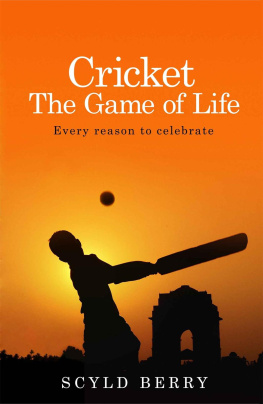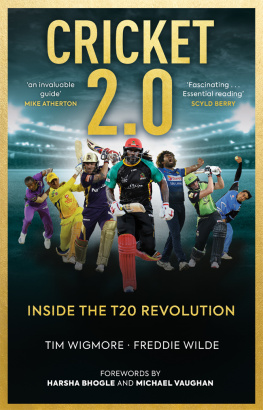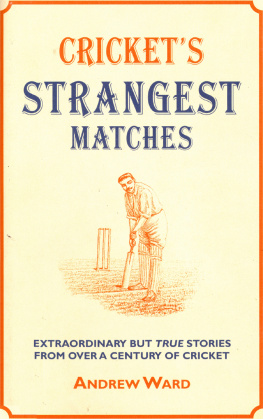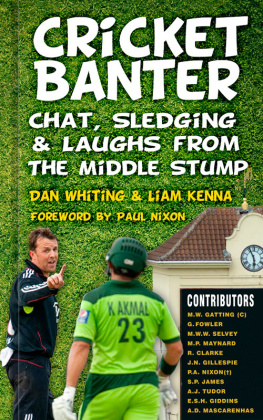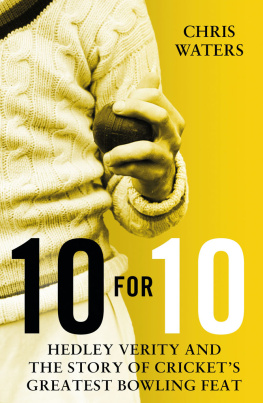Among the Fans
by
Patrick Collins
WELL GET
EM IN
SEQUINS
Manliness, Yorkshire Cricket and the
Century That Changed Everything
MAX
DAVIDSON

Published in the UK in 2012 by
John Wisden & Co
This electronic edition published in 2012 by Bloomsbury Publishing Plc
An imprint of Bloomsbury Publishing Plc
50 Bedford Square, London WC1B 3DP
www.bloomsbury.com
www.wisden.com
Copyright Max Davidson 2012
ISBN: 978 1 4081 7114 1
All rights reserved. You may not copy, distribute, transmit, reproduce or otherwise make available this publication (or any part of it) in any form, or by any means (including without limitation electronic, digital, optical, mechanical, photocopying, printing, recording or otherwise), without the prior written permission of the publisher. Any person who does any unauthorised act in relation to this publication may be liable to criminal prosecution and civil claims for damages.
Every reasonable effort has been made to trace copyright holders of material reproduced in this book, but if any have been inadvertently overlooked the publishers would be glad to hear from them.
Max Davidson has asserted his right under the Copyright, Design and Patents Act, 1988, to be identified as the author of this work.
A CIP catalogue record for this book is available from the British Library.
Visit www.bloomsbury.com to find out more about our authors and their books You will find extracts, author interviews, author events and you can sign up for newsletters to be the first to hear about our latest releases and special offers
To the immortal memory of George Hirst and Wilfred Rhodes, who got em in singles.
In appreciation of the generations of Yorkshire cricketers who grafted, played the game hard, never gave away owt and found the poetry in maiden overs; whose mams could have played Shane Warne with a stick of rhubarb; and who, for nearly a century, were the backbone of the England cricket team.
And for Darren Gough and Michael Vaughan for daring to be different.
In an England cricket 11, the flesh may be
of the South, but the bone is of the North,
and the backbone is Yorkshire.
Sir Leonard Hutton
On the afternoon of 13 August 1902, at the end of a famous Test match against Australia at the Oval, all eyes were on two professional cricketers from Yorkshire: fast bowler George Hirst and left-arm spinner Wilfred Rhodes. The foundations of an England victory had been laid by a Flash Harry amateur from Gloucestershire, Gilbert Jessop, with a whirlwind century, but now it was down to the bowlers: 15 runs to make, and the last pair at the crease. The situation called for cool heads, unflinching bodies and that most elusive sporting quality patience.
Well get em in singles, Hirst said to Rhodes, as the two men conferred midwicket. Did he really say it? Or is it one of those apocryphal quotations one hates to let go, like a childhood friend? Hirst himself disclaimed the quote, but if he didnt say it, he should have said it, just as Sherlock Holmes should have said, Elementary, my dear Watson, but never did. The quotation has stuck because it is so true to the man to whom it is attributed: a phlegmatic, pipe-smoking Yorkshireman with a bog-standard Edwardian moustache, an air of unhurried competence and a hatred of anything that smacked of excess or ostentation.
He and Rhodes got em in singles or, pace the late Bill Frindall, got most of em in singles, and won a famous victory for their side. The crowd went wild. Hats were thrown in the air. But the two Yorkshiremen in the middle were unruffled. They always were.
You did your job, you got paid a few quid, you had a beer after the match, and then you went home. But you didnt make a song and dance about it. In fact, you didnt make a song and dance about anything, certainly not if you came from Yorkshire, most sober and upright of counties.
That was the world of the professional cricketer which George Hirst inhabited, and which he graced with distinction for more than 30 years. It was a small world, a narrow world, but it was rooted in good soil, and the sporting heroes it produced were as admired by their contemporaries as any modern superstar, perhaps more so.
Just over a century later, on the same ground, in a Test match against the same opponents, another Yorkshireman took centre stage, as the England captain Michael Vaughan held the replica Ashes aloft and a nation went bananas. There were some striking similarities between the Ashes Tests of 1902 and 2005. Kevin Pietersen in 2005 might have been Gilbert Jessop brought back to life, biffing six after six in a never-to-be-forgotten century. But there were differences, too. Vaughan failed with the bat on the final day, but played a blinder in the dressing room in the lunch interval, encouraging Pietersen to go for his shots rather than play the dogged rearguard innings that the situation seemed to demand, with England needing only a draw to retain the Ashes. George Hirst would never have been so cavalier, so incautious, not in a thousand years. Cricket had changed. Yorkshire had changed. The world had changed.
Vaughan, born in Manchester but brought up in Sheffield, broke the mould, first as a free-flowing batsman, then as a captain who prized aggression above containment, self-expression above efficiency. He had no appetite for the uncompromising maiden overs that had been meat and drink to generations of Yorkshire cricket fans. He played the game with a lack of inhibition that both appalled and titillated the traditionalists.
You dont understand this, do you? Tony Greig asked fellow commentator Geoff Boycott, as Vaughans England hurtled to 400 in a day at the start of the 2005 Edgbaston Test. Youre right, said Boycott, as proud a son of Yorkshire as ever played with his bat close to his pad. I dont. Its fun, though. It was as if Yorkshire, once the gold standard of English cricket, a temple of rectitude, had suddenly become two Yorkshires: Old Yorkshire, epitomised by Boycott and the players he had grown up with Fred Trueman, Brian Close, Ray Illingworth and a new, less hard-bitten, generation of players. They did things differently, not because they had a different tactical appreciation of cricket, but because they were different men, in a changing world.
Relaxed, self-confident, comfortable in his own skin, Michael Vaughan was as much a man of his times as George Hirst had been. In 2004, captaining England against New Zealand, he left the ground before the end of play to attend the birth of his first child. Nobody batted an eyelid. In 2008, at the press conference when he resigned the England captaincy, he blubbed like a baby. Again, nobody batted an eyelid. Men did these things even mens men who played cricket, took some hard knocks, then went out drinking with Freddie Flintoff.
Vaughans period as England captain became synonymous not just with success on the field, but with the famous huddle: the circle formed by the fielding side at the start of play, with players putting their arms around each others shoulders, geeing each other up with psychobabble, then patting each others bottoms as they dispersed. What would Brian Close or Ray Illingworth have made of a bonding ritual with such homoerotic overtones? One shudders to think.
And if you were Old Yorkshire, and believed in Old Yorkshire ways, things were about to get ten times worse.
In the autumn of 2005, within weeks of Michael Vaughan holding the Ashes aloft at the Oval, the Yorkshire fast bowler Darren Gough having already dismayed the traditionalists by tearing in to bowl wearing an ear-stud went the whole fashion hog, appearing on the BBCs


